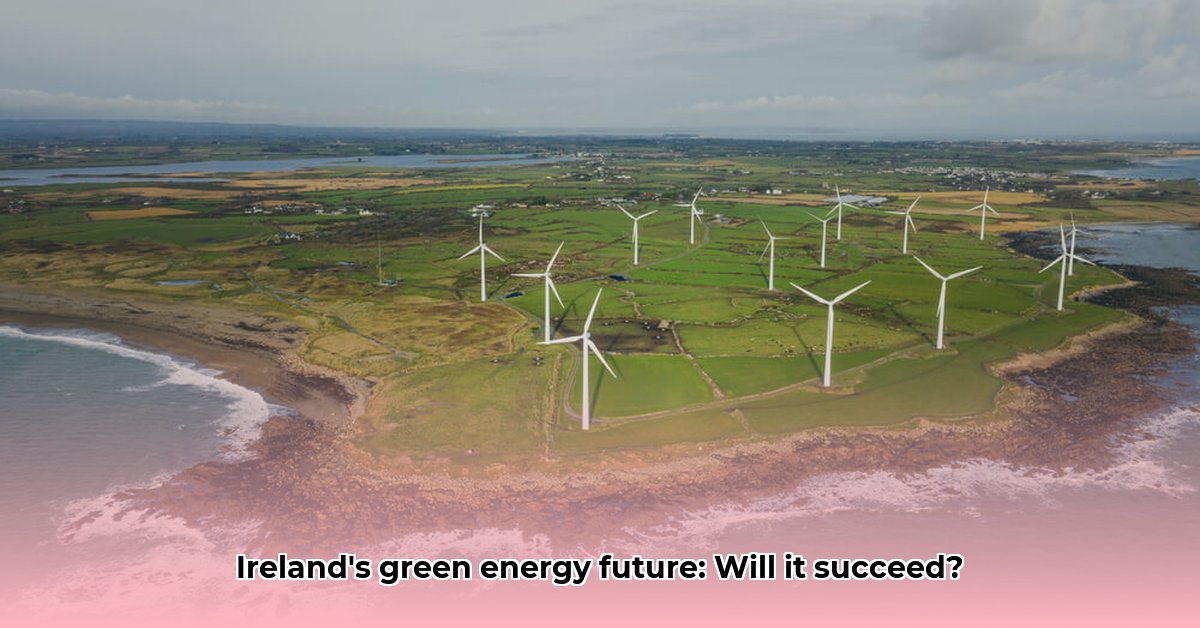
Ireland is embarking on an ambitious journey towards a renewable energy future, aiming for significant progress by 2030 and beyond. This transition, however, presents a complex interplay of opportunities and challenges. This article explores Ireland's strategies for achieving its renewable energy targets, examining the successes and obstacles encountered, and outlining a path forward. For a broader perspective on energy market integration, see Ireland's Single Electricity Market.
Harnessing the Power of the Sea: Offshore Wind Energy
Offshore wind farms represent a cornerstone of Ireland's renewable energy strategy. The vast potential of harnessing wind power at sea is undeniable; however, realizing this potential requires meticulous planning and execution. Visualize colossal wind turbines gracefully rotating in the Atlantic breeze, generating clean energy for generations. This image, however, is only half the picture. Success hinges on securing significant investment, streamlining the often cumbersome permitting process, and fostering collaborative partnerships among stakeholders.
"Developing offshore wind farms isn't simply about construction; it requires a delicate balance between economic growth and environmental protection," explains Dr. Aoife O’Connell, Head of Marine Research, University College Cork. "We must ensure the coexistence of offshore wind energy with other marine activities, including fishing, to minimize conflict and maximize sustainability. A comprehensive, transparent approach is crucial."
This necessitates strategic planning to ensure the compatibility of offshore wind farm development with established marine industries. How can we effectively balance the economic benefits of these large-scale projects with the need to protect Ireland's valuable marine ecosystems? This is a question that demands careful consideration and innovative solutions.
Navigating the Regulatory Landscape: Adapting to RED III and Beyond
The European Union's Renewable Energy Directives (REDs), particularly the recently implemented RED III, significantly influence Ireland's energy transition, presenting both opportunities and significant regulatory hurdles. RED III introduces stringent new requirements, demanding swift adaptation and proactive planning. One key challenge lies in accurately measuring and reporting renewable energy contributions in the transportation sector. Improving data collection and analysis procedures will be crucial to avoid past reporting inconsistencies.
"RED III demands a proactive and adaptive response from Ireland," notes Mr. Liam O'Brien, Senior Policy Advisor at the Sustainable Energy Authority of Ireland (SEAI). "Failure to adapt effectively could result in penalties and hinder our progress toward national and EU renewable energy targets. This calls for careful evaluation of various compliance strategies and investment in robust monitoring systems."
The complexities introduced by RED III necessitate a comprehensive understanding of the regulations and their implications for various sectors. What strategies will Ireland employ to efficiently navigate these new rules, ensuring compliance while maintaining economic competitiveness?
Building a Smarter Grid: The Importance of Digital Infrastructure
To effectively manage the influx of renewable energy – particularly from large-scale offshore wind projects – Ireland needs a sophisticated and adaptable smart grid. This intelligent system is not just about monitoring energy flow. It is essential for predicting and mitigating disruptions, optimizing energy distribution, and ensuring system-wide efficiency. A robust smart grid infrastructure acts as the nervous system of Ireland's renewable energy system.
"A smart grid is not optional; it is essential for the successful integration of Ireland's growing renewable energy portfolio," states Ms. Niamh Kelly, Chief Technology Officer, EirGrid (Ireland's electricity transmission system operator). "Without a modernized, adaptable smart grid, we risk system instability and cannot fully realize the benefits of clean energy."
This highlights the urgent need for investment and development in Ireland's smart grid infrastructure. This investment is not merely an expense but a crucial step in maximizing the efficiency and reliability of the country's renewable energy transition. How will Ireland address the technological and financial challenges of upgrading its grid infrastructure to meet the demands of a rapidly changing energy landscape?
Collaborative Action: A Multi-Stakeholder Approach
The successful implementation of Ireland's renewable energy transition requires a collaborative effort involving various stakeholders. The government, energy developers, marine users, and citizens all play crucial roles. This necessitates transparent communication, effective partnership building, and coordinated planning.
The following table summarizes key short-term and long-term actions required by different stakeholder groups:
| Stakeholders | Short-Term Actions (0-1 Year) | Long-Term Actions (3-5 Years) |
|---|---|---|
| Government | Finalize and implement the plan for offshore renewable energy; secure funding | Fully functioning plan for offshore wind; secure diverse funding sources; create robust, up-to-date regulations based on RED III |
| Industry (Developers) | Obtain permits; begin investment; develop co-existence strategies | Increase offshore wind construction; develop expertise in grid integration; invest in innovation |
| Marine Stakeholders | Participate in collaborative planning; implement mitigation measures | Ensure long-term co-existence strategies; participate in monitoring projects |
| Citizens | Access project details; participate in public consultations | Benefit from improved energy security and lower energy costs |
Mitigating Risks: Proactive Strategies for a Smooth Transition
Numerous potential risks could hinder Ireland's renewable energy transition. Proactive risk mitigation strategies are essential.
| Risk Category | Description | Likelihood | Impact | Mitigation |
|---|---|---|---|---|
| Regulatory Changes | Shifts in EU or national regulations | Moderate | High | Continuous monitoring of regulations; flexible project design; active policy engagement |
| Technical Issues | Delays or malfunctions in technology deployment | Low | Moderate | Rigorous testing; contingency planning; phased implementation |
| Environmental Impacts | Negative effects on marine life | Moderate | Moderate | Comprehensive environmental impact assessments; mitigation measures; ongoing monitoring |
| Stakeholder Conflicts | Disagreements between different groups involved | Moderate | Moderate | Collaborative planning; clear communication; conflict resolution mechanisms |
| Economic Uncertainty | Fluctuations in energy prices or investment costs | High | Moderate | Diversified funding; robust financial planning; shared risk-taking |
Ireland's journey to a renewable energy future demands careful planning, innovative solutions, and a commitment to collaboration. By proactively addressing the challenges and leveraging the abundant opportunities, Ireland can successfully achieve its ambitious goals and establish itself as a leader in the global renewable energy transition. The path ahead is challenging, but the promise of a cleaner, more sustainable energy future makes the effort worthwhile.